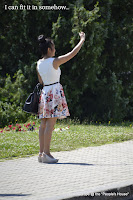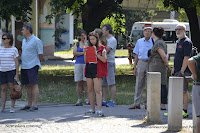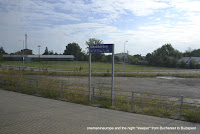The People's House
 Waking up to sunshine on the day 4 of my journey you may ask what happened to day 3? If you recall we had thunder and lightning on my return journey from Sinaia. Torrential rain continued throughout Monday completely ruining the day. I finally ventured out of the hotel in the afternoon in search of food and found that the restaurant was clearing the tables around me as I ate, the rain pouring in from the street and through the gaps the woodwork. It would have been an ideal day for visiting the People's Palace, the main reason why I came to Bucharest, however when I checked on the internet I discovered that you have to phone a particular number and book a ticket 24 hours in advance. Fortunately I was able to book 12 o'clock tour around the palace before afternoon my departure. As soon as you pull up outside you can see how dramatic this building is. it is the largest administrative building in the world, second only to the US Pentagon, and the most expensive to run. Collecting my ticket, I discovered that you can buy a ticket on the day, the Thai lady and her son joined the same tour as me. Taking photos on your mobile is free but I had to pay 30 lei (about £6) to use my camera!
Waking up to sunshine on the day 4 of my journey you may ask what happened to day 3? If you recall we had thunder and lightning on my return journey from Sinaia. Torrential rain continued throughout Monday completely ruining the day. I finally ventured out of the hotel in the afternoon in search of food and found that the restaurant was clearing the tables around me as I ate, the rain pouring in from the street and through the gaps the woodwork. It would have been an ideal day for visiting the People's Palace, the main reason why I came to Bucharest, however when I checked on the internet I discovered that you have to phone a particular number and book a ticket 24 hours in advance. Fortunately I was able to book 12 o'clock tour around the palace before afternoon my departure. As soon as you pull up outside you can see how dramatic this building is. it is the largest administrative building in the world, second only to the US Pentagon, and the most expensive to run. Collecting my ticket, I discovered that you can buy a ticket on the day, the Thai lady and her son joined the same tour as me. Taking photos on your mobile is free but I had to pay 30 lei (about £6) to use my camera!
We enter richly carpeted marble corridor where we are introduced to characters from Romania's pre-communist past. A rather frightening bust of Stephen III of Moldavia, b.1433-d.1504, to the left. With the help of his friend, Vlad the Impaler, he secured the throne in 1457 and became Stefan cel Mar (Stephan the Great). He reigned for more than 47 years, quite an achievement given the pressure from the Ottoman Empire and the ever changing alliances around his kingdom. With a despotic cruelty, bad temper, and diminutive stature legend has it that he protected the peasants from the nobles and foreigners. A dubious claim considering the way he regularised slavery, reportedly capturing as many as 17,000 Gypsies during his invasion of Wallachia whom he used for his own purposes. He became a rallying figure in the late 18th century independence movement.
Moving on into the first of the many halls we will visit, this auditorium lit by a giant chandelier was used to address the members of government. Bearing in mind that the country was run by a dictator this was probably his favourite room. There are no microphones to talk back! Our guide bombards us with facts and figures. Construction began on 'The People's House' in 1983, with the cornerstone laid June 25, 1984. Some 700 Romanian architects purportedly collaborated on its design which combines elements and motifs from a multitude of classical sources. Measuring 270
metres wide by 240m long, 86m high and 92m underground, the People's Palace is 12 stories tall with an undisclosed number of underground levels (at least 8) in varying stages of completion. It's 1,100 rooms were apparently constructed strictly from Romanian materials, though most locals seem sceptical of this. Estimates of the materials used include 1 million cubic metres of Transylvanian marble, 3,500 metric tonnes of crystal for the 480 chandeliers and 1,409 lights and mirrors that were manufactured, 700,000 tonnes of steel and bronze, 900,000 cubic metres of wood and 200,000 square metres of woven carpets, many of which were spun on site. Lights are now lit alternately due to the vast expense.
Moving on, keep up, don't leave the group, this is a working building though how much is occupied is anyone's guess. We climb another marble and bronze staircase and emerge in the wing used by the TV and press for reports and interviews. It is decorated with cases containing life size figures in regional costume. We are asked which floor we are on becoming totally confused as we are on the 1st. The grand entrance was designed at this level. We walk on, our guide giving more facts and figures along with some anecdotes. Some questions are left unanswered and some unasked.
By now I am lost and still lost when I review the photos. For those in the know, the design in the marble floor contains coded dots to establish direction. We are taken into many grand conference rooms including one with a secret door so that Ceausescu could appear from within the room. The grand marble staircase mirrored exactly on the other side of the reception hall so that his wife could descend opposite him. The reception room specially constructed to make a hand clap or cheer sound like ten and the huge ballroom at the end with its high windows looking down onto the city below. Sumptuous in construction yet lifeless. Like it's creator it is a building without a heart.
I didn't clime the grand staircase to see the balcony and view of the city. By this time I was hot, tired and dispirited by this oppressive building. The young lady from Thailand, visiting with her son, features heavily to brighten up some of the shots and give perspective to the sheer size of the building, corridors seem to go on forever. She helped me with the stairs and explained that she is here with her Polish boyfriend for a few weeks before the move there permanently and marry. Ceausescu impoverished a nation but the world turns and hope for a better life springs eternal. Visit the palace, it gives a perspective and a comparison as you will see later in my journey. There is also a basement tour but not for the infirm, sums it up really. Exchanging ID tags for passports we head back out into the sunshine.
View "The People's House" photo album and/or The full "Romania Photo Diary" album
Moving on into the first of the many halls we will visit, this auditorium lit by a giant chandelier was used to address the members of government. Bearing in mind that the country was run by a dictator this was probably his favourite room. There are no microphones to talk back! Our guide bombards us with facts and figures. Construction began on 'The People's House' in 1983, with the cornerstone laid June 25, 1984. Some 700 Romanian architects purportedly collaborated on its design which combines elements and motifs from a multitude of classical sources. Measuring 270
metres wide by 240m long, 86m high and 92m underground, the People's Palace is 12 stories tall with an undisclosed number of underground levels (at least 8) in varying stages of completion. It's 1,100 rooms were apparently constructed strictly from Romanian materials, though most locals seem sceptical of this. Estimates of the materials used include 1 million cubic metres of Transylvanian marble, 3,500 metric tonnes of crystal for the 480 chandeliers and 1,409 lights and mirrors that were manufactured, 700,000 tonnes of steel and bronze, 900,000 cubic metres of wood and 200,000 square metres of woven carpets, many of which were spun on site. Lights are now lit alternately due to the vast expense.
Moving on, keep up, don't leave the group, this is a working building though how much is occupied is anyone's guess. We climb another marble and bronze staircase and emerge in the wing used by the TV and press for reports and interviews. It is decorated with cases containing life size figures in regional costume. We are asked which floor we are on becoming totally confused as we are on the 1st. The grand entrance was designed at this level. We walk on, our guide giving more facts and figures along with some anecdotes. Some questions are left unanswered and some unasked.
By now I am lost and still lost when I review the photos. For those in the know, the design in the marble floor contains coded dots to establish direction. We are taken into many grand conference rooms including one with a secret door so that Ceausescu could appear from within the room. The grand marble staircase mirrored exactly on the other side of the reception hall so that his wife could descend opposite him. The reception room specially constructed to make a hand clap or cheer sound like ten and the huge ballroom at the end with its high windows looking down onto the city below. Sumptuous in construction yet lifeless. Like it's creator it is a building without a heart.
I didn't clime the grand staircase to see the balcony and view of the city. By this time I was hot, tired and dispirited by this oppressive building. The young lady from Thailand, visiting with her son, features heavily to brighten up some of the shots and give perspective to the sheer size of the building, corridors seem to go on forever. She helped me with the stairs and explained that she is here with her Polish boyfriend for a few weeks before the move there permanently and marry. Ceausescu impoverished a nation but the world turns and hope for a better life springs eternal. Visit the palace, it gives a perspective and a comparison as you will see later in my journey. There is also a basement tour but not for the infirm, sums it up really. Exchanging ID tags for passports we head back out into the sunshine.
View "The People's House" photo album and/or The full "Romania Photo Diary" album
What your guide doesn't tell you....
As once regal and cosmopolitan Bucharest lay in decay after two World Wars and a devastating earthquake in 1977, Romania's Communist dictator Nicolae Ceausescu was coming to the height of his power and megalomania. By creating a pervasive cult of personality (calling himself 'Conducator' ('Leader'), 'Geniul din Carpati' ('Genius of the Carpathians') and even having a king-like scepter made for himself), Ceausescu projected his own narcissism onto the people, wishing to erase everything as it was before him from the popular imagination. Promoting the 'Civic Centre' project as the creation of a 'multilaterally developed socialist society,' Ceausescu began to demolish the deteriorating capital and rebuild it in his own vision, culminating in the construction of 'Casa Poporului,' or the 'People's House' as it was to be ironically titled. [The name of the structure was changed to 'The Palace of Parliament' after the fall of communism, however most Romanians still refer to it as 'Casa Poporului.']
Ceausescu achieved the idea for 'The People's House' after a visit to North Korea's Kim II-sung in 1972. The 'People's House' would be the largest, most lavish palace in the world and would hold all the functions of his socialist state, as well as serve as a handsome residence for he and his wife. Leading to the Palace would be Boulevard 'Victory of Socialism' (now Boulevard Unirii), the Champs Elysees of Bucharest (but deliberately designed to be 1 metre wider on each side and 6 metres longer than Paris' thoroughfare), stretching from Piata Alba Iulia to the Palace premises.
Though no figures have been officially released, it is said that some 20,000 workers toiled in 24-hour shifts, seven days a week, to build the Palace at the pace at which it was being constructed. To finance the project, Ceausescu had to take on enormous foreign debts. In order to repay these debts he systematically starved the Romanian people, exporting all of the country's agricultural and industrial production as the standard of living in Romania sank to an all time low. Food-rationing, gas electric and heating blackouts became everyday norms; people lived in squalor and poverty as the Ceausescu's themselves exhibited outrageous extravagance.
The Romanian Revolution of 1989 broke out just as the People's Palace was nearing completion. Mass protests in December 1989 in Timisoara caused martial law to be declared, a Bucharest rally turned to riot and the Ceausescus were forced to flee the capital by helicopter. They were soon after captured by police in Targoviste after abandoning their chopper, were sentenced to death by an ad hoc military court on charges ranging from illegal gathering of wealth to genocide and were executed by firing squad on Christmas Day, 1989.
After Ceausescu's deposition, the new government moved its functions into his maniacal mansion and it was renamed the Palace of Parliament. Today it also houses the National Museum of Contemporary Art (MNAC), however most of the premises goes unoccupied. Though many find the Palace to be aesthetically unappealing, the exquisite craftsmanship of the marble staircases, carved wooden balconies, crystal chandeliers and whatnot cannot be denied. During your visit you'll only see 5% of the structure, but you will be able to step onto the balcony from which Ceausescu planned to address his people had they not executed him first. Instead, the balcony was first used by pop star Michael Jackson, who declared to the adoring crowd below, "I LOVE BUDAPEST!" [Moments later MJ was forced to escape by private helicopter back to his Neverland Ranch.]











Comments
Post a Comment